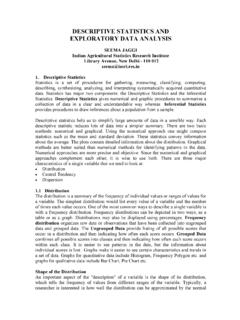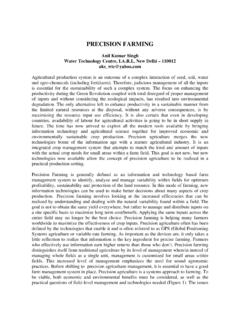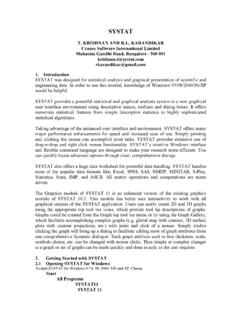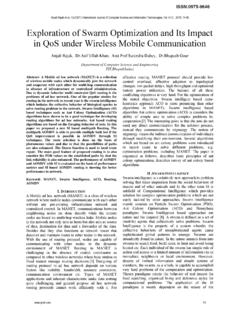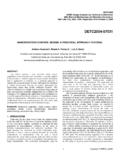Transcription of ARTIFICIAL NEURAL NETWORKS AND ITS …
1 ARTIFICIAL NEURAL NETWORKS AND ITS APPLICATIONS Girish Kumar Jha , New Delhi-110 012 Introduction NEURAL NETWORKS have seen an explosion of interest over the last few years and are being successfully applied across an extraordinary range of problem domains, in areas as diverse as finance, medicine, engineering, geology, physics and biology. The excitement stems from the fact that these NETWORKS are attempts to model the capabilities of the human brain. From a statistical perspective NEURAL NETWORKS are interesting because of their potential use in prediction and classification problems. ARTIFICIAL NEURAL NETWORKS (ANNs) are non-linear data driven self adaptive approach as opposed to the traditional model based methods. They are powerful tools for modelling, especially when the underlying data relationship is unknown. ANNs can identify and learn correlated patterns between input data sets and corresponding target values.
2 After training, ANNs can be used to predict the outcome of new independent input data. ANNs imitate the learning process of the human brain and can process problems involving non-linear and complex data even if the data are imprecise and noisy. Thus they are ideally suited for the modeling of agricultural data which are known to be complex and often non-linear. A very important feature of these NETWORKS is their adaptive nature, where learning by example replaces programming in solving problems. This feature makes such computational models very appealing in application domains where one has little or incomplete understanding of the problem to be solved but where training data is readily available. These NETWORKS are NEURAL in the sense that they may have been inspired by neuroscience but not necessarily because they are faithful models of biological NEURAL or cognitive phenomena.
3 In fact majority of the network are more closely related to traditional mathematical and/or statistical models such as non-parametric pattern classifiers, clustering algorithms, nonlinear filters, and statistical regression models than they are to neurobiology models. NEURAL NETWORKS (NNs) have been used for a wide variety of applications where statistical methods are traditionally employed. They have been used in classification problems, such as identifying underwater sonar currents, recognizing speech, and predicting the secondary structure of globular proteins. In time-series applications, NNs have been used in predicting stock market performance. As statisticians or users of statistics, these problems are normally solved through classical statistical methods, such as discriminant analysis, logistic regression, Bayes analysis, multiple regression, and ARIMA time-series models. It is, therefore, time to recognize NEURAL NETWORKS as a powerful tool for data analysis.
4 ARTIFICIAL NEURAL NETWORKS and its Applications V-42 Characteristics of NEURAL NETWORKS The NNs exhibit mapping capabilities, that is, they can map input patterns to their associated output patterns. The NNs learn by examples. Thus, NN architectures can be trained with known examples of a problem before they are tested for their inference capability on unknown instances of the problem. They can, therefore, identify new objects previously untrained. The NNs possess the capability to generalize. Thus, they can predict new outcomes from past trends. The NNs are robust systems and are fault tolerant. They can, therefore, recall full patterns from incomplete, partial or noisy patterns. The NNs can process information in parallel, at high speed, and in a distributed manner. Basics of ARTIFICIAL NEURAL NETWORKS The terminology of ARTIFICIAL NEURAL NETWORKS has developed from a biological model of the brain.
5 A NEURAL network consists of a set of connected cells: The neurons. The neurons receive impulses from either input cells or other neurons and perform some kind of transformation of the input and transmit the outcome to other neurons or to output cells. The NEURAL NETWORKS are built from layers of neurons connected so that one layer receives input from the preceding layer of neurons and passes the output on to the subsequent layer. A neuron is a real function of the input vector()kyy,,1K. The output is obtained as += =kijijjjywfxf1)( , where fis a function, typically the sigmoid (logistic or tangent hyperbolic) function. A graphical presentation of neuron is given in figure below. Mathematically a Multi-Layer Perceptron network is a function consisting of compositions of weighted sums of the functions corresponding to the neurons. Figure: A single neuron ARTIFICIAL NEURAL NETWORKS and its Applications V-43 NEURAL NETWORKS architectures An ANN is defined as a data processing system consisting of a large number of simple highly inter connected processing elements ( ARTIFICIAL neurons) in an architecture inspired by the structure of the cerebral cortex of the brain.
6 There are several types of architecture of NNs. However, the two most widely used NNs are discussed below: Feed forward NETWORKS In a feed forward network , information flows in one direction along connecting pathways, from the input layer via the hidden layers to the final output layer. There is no feedback (loops) , the output of any layer does not affect that same or preceding layer. Figure: A multi-layer feed forward NEURAL network Recurrent NETWORKS These NETWORKS differ from feed forward network architectures in the sense that there is at least one feedback loop. Thus, in these NETWORKS , for example, there could exist one layer with feedback connections as shown in figure below. There could also be neurons with self-feedback links, the output of a neuron is fed back into itself as input. Figure: A recurrent NEURAL network Input layer Hidden layer Output layer Input layer Hidden layer Output layer ARTIFICIAL NEURAL NETWORKS and its Applications V-44 Learning/Training methods Learning methods in NEURAL NETWORKS can be broadly classified into three basic types: supervised, unsupervised and reinforced.
7 Supervised learning In this, every input pattern that is used to train the network is associated with an output pattern, which is the target or the desired pattern. A teacher is assumed to be present during the learning process, when a comparison is made between the network s computed output and the correct expected output, to determine the error. The error can then be used to change network parameters, which result in an improvement in performance. Unsupervised learning In this learning method, the target output is not presented to the network . It is as if there is no teacher to present the desired patterns and hence, the system learns of its own by discovering and adapting to structural features in the input patterns. Reinforced learning In this method, a teacher though available, does not present the expected answer but only indicates if the computed output is correct or incorrect. The information provided helps the network in its learning process.
8 A reward is given for a correct answer computed and a penalty for a wrong answer. But, reinforced learning is not one of the popular forms of learning. Types of NEURAL NETWORKS The most important class of NEURAL NETWORKS for real world problems solving includes Multilayer Perceptron Radial Basis Function NETWORKS Kohonen Self Organizing Feature Maps Multilayer Perceptrons The most popular form of NEURAL network architecture is the multilayer perceptron (MLP). A multilayer perceptron: has any number of inputs. has one or more hidden layers with any number of units. uses linear combination functions in the input layers. uses generally sigmoid activation functions in the hidden layers. has any number of outputs with any activation function. has connections between the input layer and the first hidden layer, between the hidden layers, and between the last hidden layer and the output layer. Given enough data, enough hidden units, and enough training time, an MLP with just one hidden layer can learn to approximate virtually any function to any degree of accuracy.
9 (A statistical analogy is approximating a function with nth order polynomials.) For this reason MLPs are known as universal approximators and can be used when you have little prior knowledge of the relationship between inputs and targets. Although one hidden layer is always sufficient provided you have enough data, there are situations where a network with two or more hidden layers may require fewer hidden units and weights than a network with one hidden layer, so using extra hidden layers sometimes can improve generalization. ARTIFICIAL NEURAL NETWORKS and its Applications V-45 Radial Basis Function NETWORKS Radial basis functions (RBF) NETWORKS are also feedforward, but have only one hidden layer. A RBF network : has any number of inputs. typically has only one hidden layer with any number of units. uses radial combination functions in the hidden layer, based on the squared Euclidean distance between the input vector and the weight vector.
10 Typically uses exponential or softmax activation functions in the hidden layer, in which case the network is a Gaussian RBF network . has any number of outputs with any activation function. has connections between the input layer and the hidden layer, and between the hidden layer and the output layer. MLPs are said to be distributed-processing NETWORKS because the effect of a hidden unit can be distributed over the entire input space. On the other hand, Gaussian RBF NETWORKS are said to be local-processing NETWORKS because the effect of a hidden unit is usually concentrated in a local area centered at the weight vector. Kohonen NEURAL network Self Organizing Feature Map (SOFM, or Kohonen) NETWORKS are used quite differently to the other NETWORKS . Whereas all the other NETWORKS are designed for supervised learning tasks, SOFM NETWORKS are designed primarily for unsupervised learning (Patterson, 1996). At first glance this may seem strange. Without outputs, what can the network learn?

